-
RESEARCH01-01-2018
Adherence of hypertension patients in the Brazil’s Family Health Strategy
Revista Brasileira de Enfermagem. 2018;71(3):1030-1037
Abstract
RESEARCHAdherence of hypertension patients in the Brazil’s Family Health Strategy
Revista Brasileira de Enfermagem. 2018;71(3):1030-1037
DOI 10.1590/0034-7167-2017-0297
Views0See moreABSTRACT
Objective:
to evaluate the adherence and associate it to blood pressure control and to follow-up observation of people with hypertension in the Brazil’s Family Health Strategy.
Method:
cross-sectional study, conducted with 417 people in treatment of hypertension, living in a municipality located in the Northwest region of the state of Paraná, Brazil. The data were collected in the first 2016 semester, using an instrument adapted and validated for the evaluation of satisfaction with the services offered by Primary Health Care. Analysis of variance and the logistic regression model were used for the treatment of variables.
Results:
it was evidenced that people with inadequate follow-up observation evaluate the relations between professional/user and the guidance to the medications used as unsatisfactory.
Conclusion:
weak guidelines and ineffective dialogue between health professionals and users might result in an inadequate follow-up observation of blood pressure control and of people with hypertension.
-
RESEARCH01-01-2018
Prevalence and factors associated with experience of intrafamilial violence by teenagers in school
Revista Brasileira de Enfermagem. 2018;71(3):1022-1029
Abstract
RESEARCHPrevalence and factors associated with experience of intrafamilial violence by teenagers in school
Revista Brasileira de Enfermagem. 2018;71(3):1022-1029
DOI 10.1590/0034-7167-2016-0546
Views0See moreABSTRACT
Objective:
To estimate prevalence of intrafamilial violence experience and its association with sociodemographic, sexual and use of alcohol/drugs variables in teenagers of a public school in Salvador, Bahia, Brazil.
Method:
Cross-sectional study with 239 teenagers. Data were collected through structured instrument, analyzed according to descriptive and inferential statistics, with multiple logistic regression.
Results:
Research pointed out a high prevalence of intrafamilial violence among teenagers (60.67%). Experience of this grievance was associated, with statistical significance, with the variables: higher age range (PR = 1.83 and 95%CI: 1.05 – 3.18) and regular use of condom (PR = 1.81 and 95%CI: 1.06 – 3.08). Violence was also associated with consumption of alcohol and marijuana.
Conclusion:
Regular use of condom and consumption of alcohol and/or marijuana represent risk behaviors to the experience of intrafamilial violence by teenagers in school, especially older than 15 years old.
-
RESEARCH01-01-2018
Persistent metabolic syndrome and risk of cardiovascular disease in children and adolescents
Revista Brasileira de Enfermagem. 2018;71(3):1013-1021
Abstract
RESEARCHPersistent metabolic syndrome and risk of cardiovascular disease in children and adolescents
Revista Brasileira de Enfermagem. 2018;71(3):1013-1021
DOI 10.1590/0034-7167-2016-0564
Views0See moreABSTRACT
Objective:
to verify persistence of metabolic syndrome (MetS) and components in overweight children and adolescents, as well as its relation to socioeconomic and demographic characteristics and to the Pathobiological Determinants of Atherosclerosis in Youth (PDAY) score.
Method:
a two-point longitudinal study: at enrollment and after a 24-month interval, with 133 individuals ages from two to 18 years. The demographic anthropomorphic and blood variables were evaluated. Analysis was carried out by simple and paired association tests, as well as multiple logistic regression.
Results:
persistent MetS was observed in 38.3% of the sample, associated cardiovascular risk (ACR) in 79.7%, reduction in arterial pressure and do HDL-c. After adjusting for age and sex, excess weight (ExpB: 0.182; CI: 0.059-0.561), low HDL-c (ExpB: 9.247; CI: 1.157-73.930) and high LDL-c (ExpB:1.915; CI: 0.921-3.979) were associated with persistent MetS.
Conclusion:
persistent MetS was associated with obesity, HDL-c and LDL-c, but not with the PDAY score.
-
01-01-2018
Nutritional status and factors associated with non-institutionalized people over 75 years of age
Revista Brasileira de Enfermagem. 2018;71(3):1007-1012
Abstract
Nutritional status and factors associated with non-institutionalized people over 75 years of age
Revista Brasileira de Enfermagem. 2018;71(3):1007-1012
DOI 10.1590/0034-7167-2017-0207
Views0See moreABSTRACT
Objective:
to determine the factors related to the risk of malnutrition in a non-institutionalized population over 75 years of age.
Method:
a cross-sectional study was conducted using a questionnaire in a sample of 326 individuals over 75 years of age in Castellón (Spain), during 2015, and selected through intentional sampling.
Results:
Malnutrition prevalence was 2.8%. 26.9% of the individuals were at risk of malnutrition, whereas women presented a higher rate (31.5%). Women with a good overall health status showed a lower rate than men, 55% and 69%, respectively. Individuals that showed a lower risk of malnutrition are those with a positive perception than those who have a good overall health. Frail elderly people showed a higher risk of malnutrition (57.5%) compared to non-frail subjects (20.2%) p< 0.001.
Conclusion:
Frail women, self-assessed health, overall health, and use of health care services (nursing consultation) were related to a higher risk of malnutrition.
-
01-01-2018
Estado nutricional y factores asociados en mayores de 75 años no institucionalizados
Revista Brasileira de Enfermagem. 2018;71(3):1007-1012
Abstract
Estado nutricional y factores asociados en mayores de 75 años no institucionalizados
Revista Brasileira de Enfermagem. 2018;71(3):1007-1012
DOI 10.1590/0034-7167-2017-0207
Views1See moreRESUMEN
Objetivo:
determinar los factores relacionados con el riesgo de desnutrición en la población de mayores de 75años no institucionalizada.
Método:
estudio transversal realizado mediante cuestionario en una muestra de 326 individuos mayores de 75 en Castellón (España), durante 2015. Seleccionados mediante muestreo intencionado.
Resultados:
Prevalencia de desnutrición 2,8%. El 26,9% de los individuos están en riesgo de desnutrición, las mujeres lo presentan en mayor proporción (31,5%). Las mujeres presentan una salud general buena en menor proporción que los hombres, el 55% frente a 69%. Tienen menor riesgo de desnutrición los individuos que tienen una percepción positiva y los que tienen una buena salud general. Los mayores frágiles presentan un mayor riesgo de desnutrición (57,5%) frente a los no frágiles (20,2%) p< 0.001.
Conclusión:
Se relacionan con mayor riesgo de desnutrición, mujeres fragilidad, percepción de la salud, salud global y utilización de Servicios sanitarios (consulta de la enfermería).
-
RESEARCH01-01-2018
Empowerment of the mothers of children in a pediatric intensive care unit
Revista Brasileira de Enfermagem. 2018;71(3):998-1006
Abstract
RESEARCHEmpowerment of the mothers of children in a pediatric intensive care unit
Revista Brasileira de Enfermagem. 2018;71(3):998-1006
DOI 10.1590/0034-7167-2016-0689
Views0See moreABSTRACT
Objective:
to analyze the process of empowerment of the mothers of children hospitalized in a pediatric intensive care unit (PICU) according to Cheryl H. Gibson’s framework.
Method:
a qualitative study with a non-directive interview in groups was carried out with 14 mothers in the PICU of a pediatric teaching hospital in the state of Rio de Janeiro, whose data were submitted to thematic analysis.
Results:
all mothers underwent at least one phase of the process of empowerment. Some of them achieved the phase of participatory competence in the care for their children, being heard by the team and expressing their needs, opinions, and questions.
Final considerations:
attentive listening and information sharing with mothers is necessary, in order to provide essential support so that they undergo the process of empowerment, thus involving themselves in care and decision-making regarding their children.
-
RESEARCH01-01-2018
Translation and adaptation of a questionnaire on the needs of postpartum adolescents
Revista Brasileira de Enfermagem. 2018;71(3):992-997
Abstract
RESEARCHTranslation and adaptation of a questionnaire on the needs of postpartum adolescents
Revista Brasileira de Enfermagem. 2018;71(3):992-997
DOI 10.1590/0034-7167-2017-0021
Views0See moreABSTRACT
Objective:
Describe the processes of translation to the Portuguese language and cultural adaptation of the Postpartum Learning Needs (PLN) to the Portuguese context.
Method:
Methodological study of an instrument that was constructed and validated in Jordan. Here are presented the procedures referring to linguistic, semantic and cultural validation, involving the stages of translation from English to European Portuguese, synthesis of translations, back-translation to the original language, expert committee, and pre-testing.
Results:
In the translation process, some vocabulary variations were solved through consensus among translators. The expert committee found that the version translated to Portuguese presented semantic, idiomatic, cultural and conceptual equivalence, while needing some adjustments. Pre-testing was applied to 45 adolescent mothers, of whom 86.6% considered the items comprehensible.
Conclusion:
Semantic, idiomatic, cultural and conceptual equivalences were conceptually satisfactory among questionnaire versions, which is relevant for the Portuguese culture and easily understandable. It is crucial to assess the psychometric properties of the questionnaire so its adapted version can be made available.
-
RESEARCH01-01-2018
Cross-cultural adaptation of the instrument Readiness for Hospital Discharge Scale – Adult Form
Revista Brasileira de Enfermagem. 2018;71(3):983-991
Abstract
RESEARCHCross-cultural adaptation of the instrument Readiness for Hospital Discharge Scale – Adult Form
Revista Brasileira de Enfermagem. 2018;71(3):983-991
DOI 10.1590/0034-7167-2017-0241
Views0See moreABSTRACT
Objective:
to perform the cross-cultural adaptation of the Readiness for Hospital Discharge Scale – (RHDS) Adult Form for use in Brazil.
Method:
a methodological study was conducted in 2015, in Brazil’s federal capital, following the eight stages scientifically established.
Results:
analysis proved the maintenance of semantic, idiomatic, cultural, and conceptual equivalences and kept both the face and content validity of the original version. The judging committee and the pre-test participants declared they understood the RHDS items and answer scale.
Conclusion:
the instrument is culturally adapted for Brazil and can be used as one of the stages for planning hospital discharge.
-
EXPERIENCE REPORT01-01-2018
Clinical and epidemiological teaching of dengue through simulated practice
Revista Brasileira de Enfermagem. 2018;71(2):451-456
Abstract
EXPERIENCE REPORTClinical and epidemiological teaching of dengue through simulated practice
Revista Brasileira de Enfermagem. 2018;71(2):451-456
DOI 10.1590/0034-7167-2016-0503
Views2See moreABSTRACT
Objective:
to describe the experience of clinical teaching on dengue and the practice of epidemiological surveillance using problematization methodology.
Method:
report of experience on educational activity with undergraduate nursing students, held in March 2016, at a public university in the city of São Paulo, conceived in four stages: dialogic lecture, active search of Aedes aegypti, case study and simulation of nursing consultation to individuals with dengue.
Results:
The activity allowed to retrieve previous knowledge about the disease, respond to exercises that addressed different clinical situations and epidemiological surveillance, including in situ evaluation of possible mosquito outbreaks, and discuss the need to expand prevention and health of the individual and the community, the impact of the media in the dissemination of cases and the coping difficulties experienced in the different levels of attention.
Conclusion:
the methodology adopted enabled qualified training of students to cope with dengue.

-
ORIGINAL ARTICLE07-18-2022
Beliefs, knowledge, actions of nursing techniques in breastfeeding in pain management in immunization
Revista Brasileira de Enfermagem. 2022;75(6):e20210546
Abstract
ORIGINAL ARTICLEBeliefs, knowledge, actions of nursing techniques in breastfeeding in pain management in immunization
Revista Brasileira de Enfermagem. 2022;75(6):e20210546
DOI 10.1590/0034-7167-2021-0546
Views1See moreABSTRACT
Objective:
Understand the beliefs, knowledge, and actions of nursing technicians on breastfeeding as a form of non-pharmacological intervention to relieve pain in newborns and infants during immunization.
Methods:
Qualitative study carried out through semi-structured interviews with nine nursing technicians from three Basic Health Units in a city in the state of São Paulo. The theoretical approach of the Belief Model and the methodological framework of Thematic Analysis supported this study.
Results:
Three themes originated: Beliefs, Knowledge, and Actions of nursing technicians.
Final considerations:
Despite knowledge about the benefits of breastfeeding as the most effective method for relieving pain in newborns and infants during vaccination, their restrictive beliefs overrode the evidence, leading them to act in ways that discourage or prevent the mother from breastfeed during vaccination. Formal training is recommended to align with current evidence-based practices.
-
REVIEW12-08-2023
Educational technologies for accident prevention due to falls in childhood: a scoping review
Revista Brasileira de Enfermagem. 2023;76:e20220807
Abstract
REVIEWEducational technologies for accident prevention due to falls in childhood: a scoping review
Revista Brasileira de Enfermagem. 2023;76:e20220807
DOI 10.1590/0034-7167-2022-0807
Views2See moreABSTRACT
Objectives:
to map evidence on educational technology use for accident prevention due to falls in childhood.
Methods:
a scoping review, carried out in October and November 2022, in the MEDLINE, Web of Science, BDENF and CINAHL databases and LILACS bibliographic index. There was no delimitation of language or time. Data were extracted and analyzed descriptively by two independent researchers. The research protocol was registered in the Open Science Framework.
Results:
twenty-six studies were selected. Booklets, pamphlets and leaflets were the most used technologies, presenting health services as the most frequent environment to develop research on fall prevention. The technologies developed were important outcomes: increased knowledge of children, family members, caregivers, health and education professionals.
Conclusions:
educational technology use makes it possible to increase knowledge, adopt safe practices and reduce falls.

-
REVIEW03-15-2024
Resources for health literacy among caregivers of prematurely born children: a scoping review
Revista Brasileira de Enfermagem. 2024;77(1):e20230062
Abstract
REVIEWResources for health literacy among caregivers of prematurely born children: a scoping review
Revista Brasileira de Enfermagem. 2024;77(1):e20230062
DOI 10.1590/0034-7167-2023-0062
Views1See moreABSTRACT
Objectives:
to map the available evidence on resources used to promote health literacy among caregivers of prematurely born children during outpatient follow-up.
Methods:
the Joanna Briggs Institute’s scope review protocol was utilized. The search encompassed six databases, incorporating studies from 2012 to 2022.
Results:
the three included publications revealed that the resources employed are: mobile applications, phone calls, individual counseling, videos, educational pamphlets, and group discussions. Implementing an education protocol during the transition home enhances scientifically grounded health promotion rates.
Conclusions:
there is limited literature addressing the health literacy of these caregivers. The nursing team plays a crucial role in health education and in developing resources applicable to these families.

-
ORIGINAL ARTICLE01-13-2024
Social representations of oncologic surgery for patients with cancer
Revista Brasileira de Enfermagem. 2024;77(6):e20230273
Abstract
ORIGINAL ARTICLESocial representations of oncologic surgery for patients with cancer
Revista Brasileira de Enfermagem. 2024;77(6):e20230273
DOI 10.1590/0034-7167-2023-0273
Views2See moreABSTRACT
Objectives:
to analyze the social representations of patients with cancer regarding oncologic surgery.
Methods:
a qualitative study based on Social Representation Theory was conducted with 126 participants between October 2021 and May 2022 in a public hospital in Rio de Janeiro. A characterization questionnaire, free evocations of the inducing term “surgery”, and semi-structured interviews with 60 participants were applied. Data were analyzed using Microsoft Excel® and IRaMuTeQ.
Results:
the central core of the representation is composed of fear, cure, hope, and removing the disease. The analysis of interviews resulted in six classes that highlight the social changes caused by treatment as well as the need for a support network to cope with the surgical process.
Final Considerations:
the representations reflect fear and hope towards the procedure and the desire to remove the disease, thus translating the cure through surgery.

-
ORIGINAL ARTICLE01-13-2024
Nurses’ perspectives on the use of telemonitoring in the management of people with diabetes and hypertension
Revista Brasileira de Enfermagem. 2024;77(6):e20230481
Abstract
ORIGINAL ARTICLENurses’ perspectives on the use of telemonitoring in the management of people with diabetes and hypertension
Revista Brasileira de Enfermagem. 2024;77(6):e20230481
DOI 10.1590/0034-7167-2023-0481
Views3See moreABSTRACT
Objectives:
to understand the perspective of nurses on the use of telemonitoring in the management of people with type 2 diabetes mellitus and arterial hypertension in primary care.
Methods:
this qualitative research involved sixteen nurses from eight municipalities in Paraná. Data were collected between November 2022 and January 2023 through inperson or remote interviews, which were audio-recorded and subjected to content analysis.
Results:
according to the nurses, telemonitoring enhances users’ knowledge about these conditions, communication and connection with the team, and productivity. However, the lack of electronic resources and equipment, high staff turnover, low user adherence, and the limited availability of professional time present significant challenges.
Final Considerations:
the effective implementation and operation of telemonitoring in the management of people with diabetes and hypertension involve both potential benefits and barriers. It is essential to have the availability of human and technological resources, managerial support, and the commitment of professionals and users.
-
ERRATUM01-13-2024
ERRATUM
Revista Brasileira de Enfermagem. 2024;77(6):e2024n6e08
Abstract
ERRATUMERRATUM
Revista Brasileira de Enfermagem. 2024;77(6):e2024n6e08
DOI 10.1590/0034-7167.20247706e08
Views2In the article “Brazilian nursing specific situation, middle and micro-range theories: a bibliometric study”, with DOI number: , published in Revista Brasileira de Enfermagem, 2024;77(4):e20230520, Chart 1:Where it read:[…]See more -
ORIGINAL ARTICLE09-29-2022
Palliative care production for health professionals in the context of home care
Revista Brasileira de Enfermagem. 2022;75(1):e20210030
Abstract
ORIGINAL ARTICLEPalliative care production for health professionals in the context of home care
Revista Brasileira de Enfermagem. 2022;75(1):e20210030
DOI 10.1590/0034-7167-2021-0030
Views1See moreABSTRACT
Objectives:
to analyze palliative care production developed by health professionals to home care patients.
Methods:
this is an exploratory study, with a qualitative approach, using the transpersonal care theoretical framework. Thirteen interviews were conducted with health professionals and 18 observations were conducted on different cases. Content analysis was performed using MAXQDA©.
Results:
actions performed: maintenance and follow-up measures to people eligible for palliative care, in acts of dialogue and “listening” to caregivers and users, conducting guidelines for the care and self-care process, performing technical procedures, delivery of materials, referrals and medical prescriptions to users.
Final Considerations:
it is perceived the need for advances in the implementation of government policies in Brazil that insert palliative care into the Health Care Network through educational, managerial and care actions that ensure human dignity, thus allowing the development of these and other palliative care interventions.
-
ORIGINAL ARTICLE12-13-2019
Accessibility of children with special health needs to the health care network
Revista Brasileira de Enfermagem. 2019;72:65-71
Abstract
ORIGINAL ARTICLEAccessibility of children with special health needs to the health care network
Revista Brasileira de Enfermagem. 2019;72:65-71
DOI 10.1590/0034-7167-2017-0899
Views0See moreABSTRACT
Objective:
To know how children with special health needs access the health care network.
Method:
This is a qualitative research of descriptive-exploratory type, developed using semi-structured interviews mediated by the Talking Map design. Participants were 19 family caregivers of these children in two Brazilian municipalities. Data were submitted to inductive thematic analysis.
Results:
Difficulties were mentioned from the diagnosis moment to the specialized follow-up, something represented by the itinerary of the c hild and his/her family in the search for the definition of the medical diagnosis and the access to a specialized professional; a gap between the children’s needs and the care offered was observed in primary health care.
Conclusion:
The access of children with special health needs is filled with obstacles such as slowness in the process of defining the child’s diagnosis and referral to a specialist. Primary health care services were replaced by care in emergency care units.
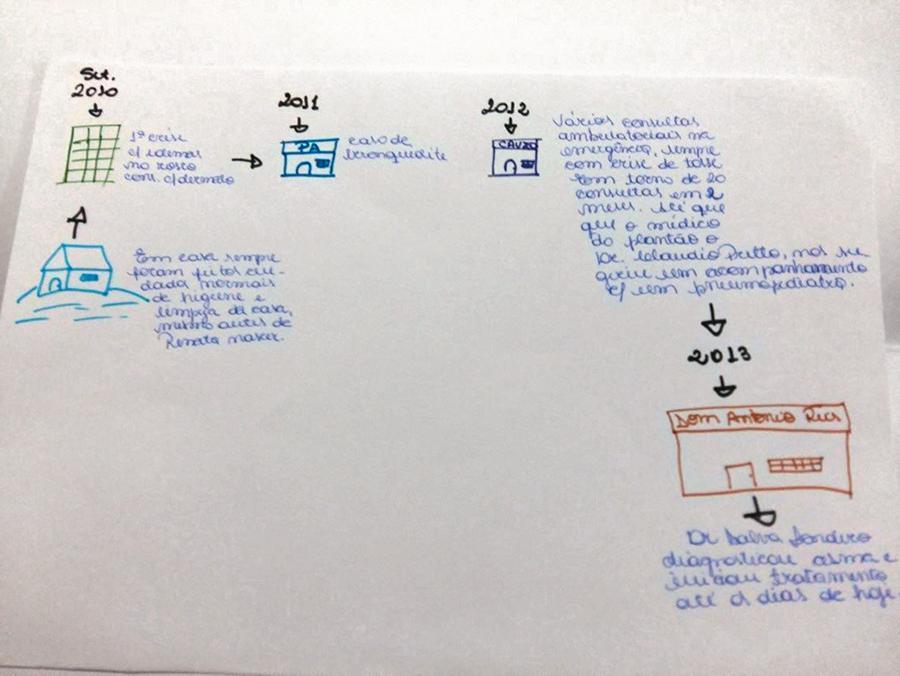
-
08-19-2019
Humor intervention in the nurse-patient interaction
Revista Brasileira de Enfermagem. 2019;72(4):1078-1085
Abstract
Humor intervention in the nurse-patient interaction
Revista Brasileira de Enfermagem. 2019;72(4):1078-1085
DOI 10.1590/0034-7167-2018-0609
Views0ABSTRACT
Objective:
To describe the factors influencing the use of humor in nursing care, its applicability and benefits.
Method:
A scoping review was performed using the Arksey and O’Mally methodology. A search for articles published between 2008 and 2018 was performed using the platforms EBSCO Host, Virtual Health Library and Google Scholar.
Results:
From the initial 465 articles found, 17 were included for final revision. Data allowed to retrieve information on humor definition; its applicability as a nursing intervention; humor as a tool to improve nurse-patient communication and relationship; influence factors; type of humor interventions; humor benefits in health care context and; limitations and precautions of humor intervention.
Conclusion:
The use of humor promotes both communication and human interaction; it promotes well-being; helps deal/cope with difficult and unpleasant situations, reduces tension, discomfort and stress; and strengthens the immune system. This intervention should be used with caution.
Keywords:CommunicationNurse-Patient RelationsNursingPatient Outcome AssessmentWit and Humor as SubjectSee more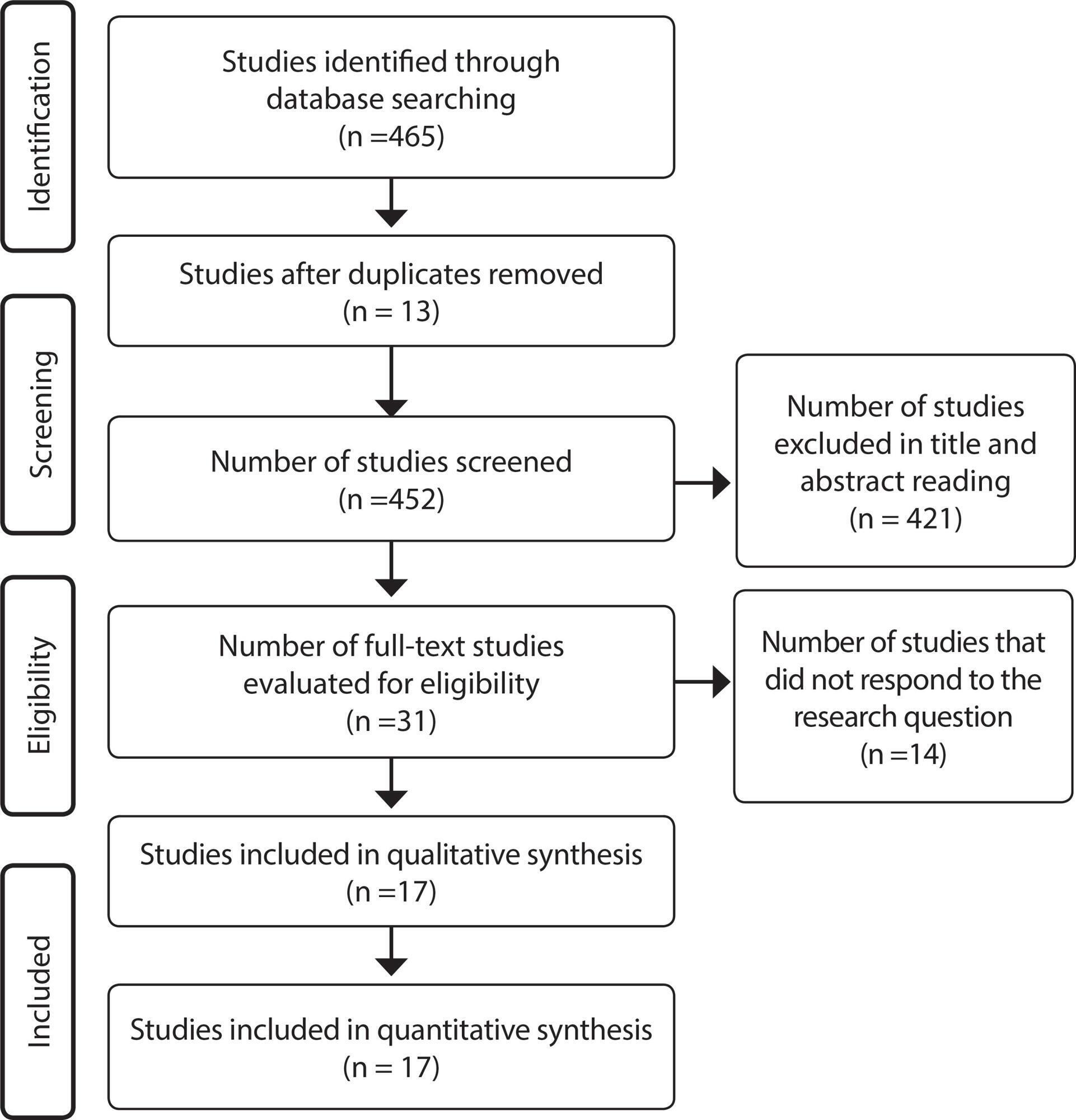
-
ORIGINAL ARTICLE07-13-2020
Incontinence-associated dermatitis in elderly patients: prevalence and risk factors
Revista Brasileira de Enfermagem. 2020;73:e20180475
Abstract
ORIGINAL ARTICLEIncontinence-associated dermatitis in elderly patients: prevalence and risk factors
Revista Brasileira de Enfermagem. 2020;73:e20180475
DOI 10.1590/0034-7167-2018-0475
Views0See moreABSTRACT
Objective:
To determine the prevalence and risk factors for incontinence-associated dermatitis in the elderly.
Method:
Cross-sectional exploratory study carried out in public hospitals. The dermatitis prevalence and associations were obtained by calculating the ratio. The effect dimension was estimated by the odds ratio with a 95% confidence interval and statistical significance p <0.05.
Results:
138 elderly people were included, with an average age of 77.2 years old (± 9.3); 69 (50%) had combined fecal and urinary incontinence. The dermatitis prevalence was 36.2% (50); 28% (14) had pressure injuries; 14% (7), candidiasis. Risk factors were: longer hospital stay (Odds Ratio = 5.8 [2.6-12.9]), obesity (Odds Ratio = 3.6 [1.2-10.4]), high level of dependence (Odds Ratio = 2.4 [1,1-5,0]) and high risk for pressure injury (Odds Ratio = 6.1 [1,4-26,9]).
Conclusion:
The study found a high prevalence of dermatitis associated with incontinence. The early recognition of risk factors favors effective preventive actions.
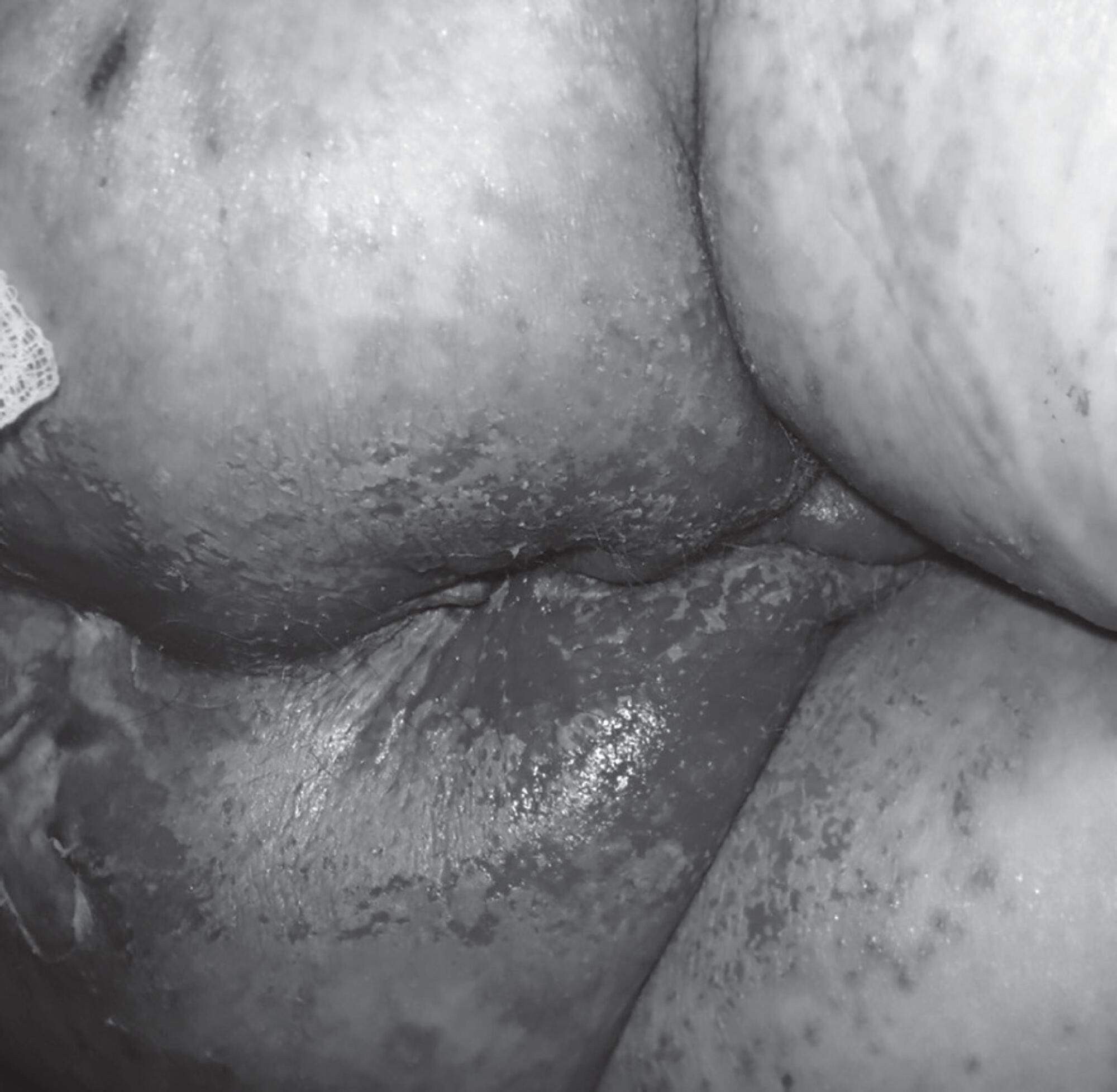
-
ORIGINAL ARTICLE10-21-2019
Workloads and burnout of nursing workers
Revista Brasileira de Enfermagem. 2019;72(6):1435-1441
Abstract
ORIGINAL ARTICLEWorkloads and burnout of nursing workers
Revista Brasileira de Enfermagem. 2019;72(6):1435-1441
DOI 10.1590/0034-7167-2017-0659
Views0See moreABSTRACT
Objective:
to identify workloads in nursing work and its association with nursing worker burnout.
Method:
a cross-sectional study, including 211 nursing workers from a university hospital, between July and August 2016. For the analysis, the descriptive statistics, Chi-Square Test, Fisher’s Exact Test and Mann Whitney U-Test were used.
Results:
the most evidenced loads were biological. A significant association was found between workloads and workers’ occupation, as well as a significant association between workloads and worker burnout. Burnout caused upper limb pain, neck and lumbar pain, lower limb pain, muscle spasm, lower limb edema, mental fatigue, headache, nervousness, and forgetfulness.
Conclusion:
workloads identification is a subsidy for the promotion of interventions that minimize the burnout generated to the health of the nursing worker.
-
ORIGINAL ARTICLE10-21-2019
Nursing care systematization: perceptions and knowledge of the Brazilian nursing
Revista Brasileira de Enfermagem. 2019;72(6):1547-1553
Abstract
ORIGINAL ARTICLENursing care systematization: perceptions and knowledge of the Brazilian nursing
Revista Brasileira de Enfermagem. 2019;72(6):1547-1553
DOI 10.1590/0034-7167-2018-0606
Views0See moreABSTRACT
Objective:
to present the perception and knowledge of Brazilian nursing nurses and academics regarding Nursing Care Systematization.
Method:
a descriptive study, carried out in the first half of 2018.
Results:
of the 596 respondents, 86% perceived Nursing Care Systematization as very important, but only 60.9% used it in their care practice. Its use was statistically associated with a higher level of training. Non-utilization was associated with the perception that it is irrelevant and with little knowledge on the Nursing Process, even in the face of recognition of its obligation. Among professionals who wish to learn more about the subject, understanding the application of the process, especially the planning step, is perceived as a necessity.
Conclusion:
the relevance perception of systematization and levels of knowledge of the professional/academic are directly related to the use or not of Nursing Care Systematization principles.

-
REVIEW12-05-2019
Vulnerability of the elderly: a conceptual analysis
Revista Brasileira de Enfermagem. 2019;72:337-344
Abstract
REVIEWVulnerability of the elderly: a conceptual analysis
Revista Brasileira de Enfermagem. 2019;72:337-344
DOI 10.1590/0034-7167-2018-0728
Views0See moreABSTRACT
Objective:
To analyze the concept of vulnerability of the elderly.
Method:
A concept analysis, according to the method proposed by Walker and Avant, operationalized through integrative review through search in scientific data portals using the
Descriptors:
Health vulnerability, aged, health services for the aged, health of the elderly, vulnerable populations and geriatric health services. To compose the literary corpus, 36 studies were selected.
Results:
Concept antecedents, as well as its attributes, were identified in individual, social and programmatic characteristics, which make up the characteristics of “vulnerability of the elderly”, besides consequences of the phenomenon. These characteristics were analyzed with emphasis on aspects that contribute to the process of vulnerability of the elderly.
Conclusion:
The study demonstrated the multidimensionality of the phenomena studied, highlighting the peculiarities of vulnerability during aging. However, there is a need for further studies on the construct.
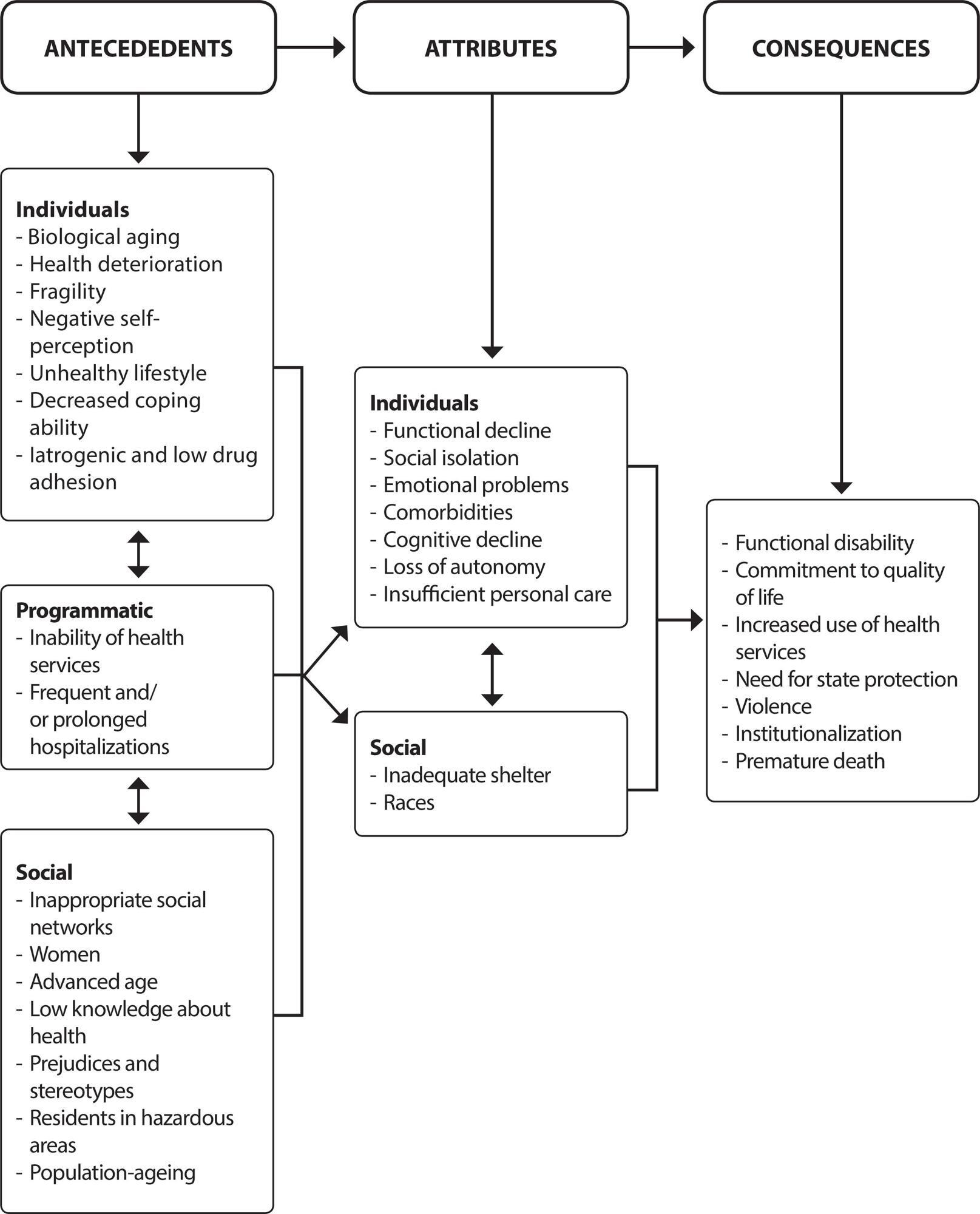
-
01-20-2021
Burnout Syndrome and Associated Factors in Intensive Care Unit Nurses
Revista Brasileira de Enfermagem. 2021;74:e20190535
Abstract
Burnout Syndrome and Associated Factors in Intensive Care Unit Nurses
Revista Brasileira de Enfermagem. 2021;74:e20190535
DOI 10.1590/0034-7167-2019-0535
Views0See moreABSTRACT
Objective:
to estimate prevalence and factors associated with Burnout Syndrome in intensive care nurses in a city in the state of Bahia.
Methods:
a cross-sectional, population-based study carried out with 65 intensive care nurses through a self-administered questionnaire, from July to November 2016, containing sociodemographic data, lifestyle, work characteristics. To define burnout syndrome, the Maslach Burnout Inventory was used.
Results:
Burnout Syndrome prevalence was 53.6%, an association was observed with age, tobacco consumption, alcohol use, weekly night shift hours, employment relationship, having an intensive care specialist title, number of patients on duty, monthly income and considering active or high-strain job.
Conclusion:
the results of this study can contribute to expanding the discussion on stressful working conditions in Intensive Care Units.
-
08-19-2019
Clinical simulation in nursing education in intensive therapy: an integrative review
Revista Brasileira de Enfermagem. 2019;72(4):1061-1070
Abstract
Clinical simulation in nursing education in intensive therapy: an integrative review
Revista Brasileira de Enfermagem. 2019;72(4):1061-1070
DOI 10.1590/0034-7167-2018-0217
Views0See moreABSTRACT
Objective:
to analyze the publications on clinical simulation practices for education in Nursing in Intensive Care.
Method:
an integrative review carried out through LILACS, PubMed, Cochrane Library, CINAHL and SciELO databases, of articles published from 2008 to 2017.
Results:
29 articles were selected, of which 76% discuss the use of simulation in continuing education of nursing professionals, while the others describe their use for student education. There is a higher prevalence of studies with a level of evidence 6 (17), with 28 international publications. There was an increase in scientific production, with 16 articles published in the last three years.
Conclusion:
variables after simulation use, such as confidence, communication skills, efficiency in the identification of clinical worsening of patients, development of technical skills, teamwork and clinical decision-making, presented a significant improvement, demonstrating that this tool is effective in qualifying care for critical patients.
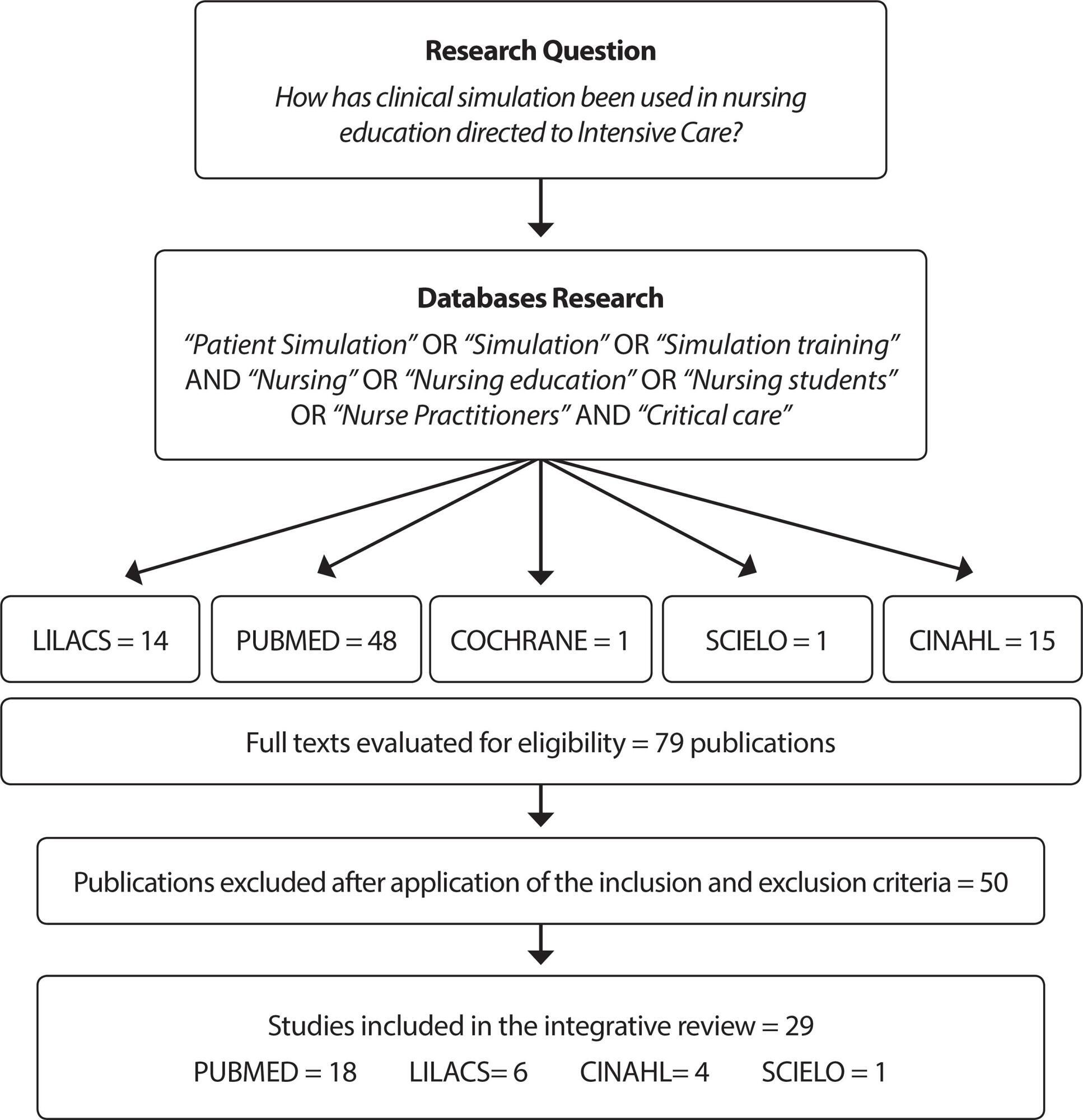
Search
Search in:
Nuvem de Tags
Adolescente (85) Atenção Primária à Saúde (239) COVID-19 (91) Criança (91) Cuidados de Enfermagem (269) Educação em Enfermagem (151) Educação em Saúde (139) Enfermagem (930) Enfermagem Pediátrica (86) Estudantes de Enfermagem (77) Estudos de Validação (131) Família (87) Idoso (208) Promoção da Saúde (99) Qualidade de Vida (104) Saúde do Trabalhador (86) Saúde Mental (145) Saúde Pública (82) Segurança do Paciente (150) Tecnologia Educacional (100)



